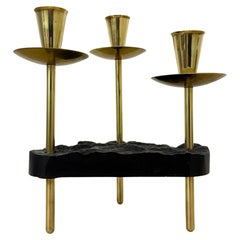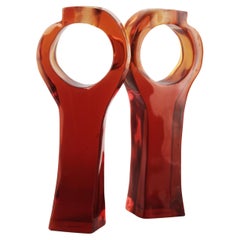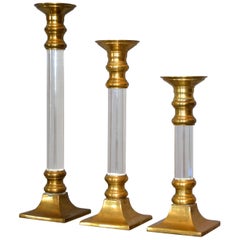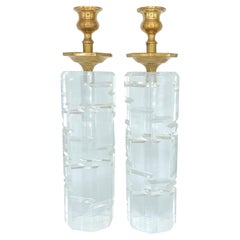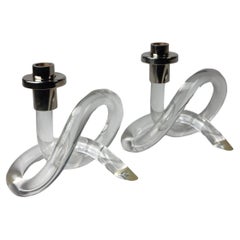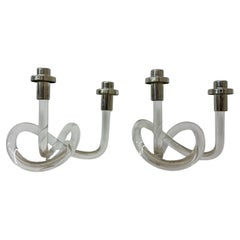Midcentury Lucite Candle Holder
Vintage 1970s German Mid-Century Modern Candlesticks
Brass
Mid-20th Century Italian Mid-Century Modern Candlesticks
Synthetic, Acrylic, Lucite, Plastic
Mid-20th Century Mid-Century Modern Candlesticks
Lucite
Vintage 1970s American Mid-Century Modern Candlesticks
Brass
Vintage 1980s American Post-Modern Candlesticks
Brass
Vintage 1970s Mid-Century Modern Candelabras
Brass
Vintage 1940s American Mid-Century Modern Candlesticks
Metal
Vintage 1970s American Mid-Century Modern Candlesticks
Chrome
Vintage 1940s American Mid-Century Modern Candlesticks
Metal
Vintage 1940s Candlesticks
Metal
Vintage 1970s Mid-Century Modern Candlesticks
Brass
Vintage 1970s American Mid-Century Modern Candlesticks
Lucite
Vintage 1970s American Mid-Century Modern Candlesticks
Chrome
Vintage 1970s Italian Mid-Century Modern Candlesticks
Metal
Vintage 1970s Spanish Mid-Century Modern Candelabras
Lucite
Vintage 1970s Dutch Mid-Century Modern Candlesticks
Lucite
Vintage 1970s French Mid-Century Modern Candlesticks
Lucite
Vintage 1970s Dutch Mid-Century Modern Candlesticks
Lucite
Vintage 1970s Mid-Century Modern Candlesticks
Lucite
Vintage 1960s American Mid-Century Modern Candlesticks
Chrome
Vintage 1950s American Candelabras
Chrome
20th Century Italian Mid-Century Modern Candlesticks
Brass
Mid-20th Century American Mid-Century Modern Candelabras
Gold Plate, Brass
Late 20th Century American Mid-Century Modern More Candle Holders
Lucite
Vintage 1960s American Mid-Century Modern Candle Holders
Brass
Mid-20th Century American Mid-Century Modern Candelabras
Chrome
20th Century North American Mid-Century Modern Candlesticks
Brass
Vintage 1980s North American Mid-Century Modern Candlesticks
Lucite
Vintage 1970s Mid-Century Modern Candelabras
Stainless Steel
20th Century American Hollywood Regency Candlesticks
Chrome
Mid-20th Century American Mid-Century Modern Candelabras
Lucite
Vintage 1970s Italian Mid-Century Modern Candlesticks
Brass
Mid-20th Century American Mid-Century Modern Candlesticks
Metal
Vintage 1960s American Mid-Century Modern Candlesticks
Brass
20th Century American Mid-Century Modern Candlesticks
Brass
20th Century Italian Mid-Century Modern Candlesticks
Lapis Lazuli, Silver Plate
Vintage 1970s Italian Mid-Century Modern Candlesticks
Metal
Antique Mid-17th Century Italian Baroque Candlesticks
Agate, Coral
Vintage 1960s American Mid-Century Modern Candlesticks
Brass
Mid-20th Century Mid-Century Modern Candlesticks
Metal
Vintage 1970s American Mid-Century Modern Candlesticks
Gold Plate
Late 20th Century European Hollywood Regency Candlesticks
Chrome
20th Century American Mid-Century Modern Candle Holders
Silver
Mid-20th Century American Mid-Century Modern Candlesticks
Silver Plate
Mid-20th Century American Post-Modern Candelabras
Chrome
Mid-20th Century American Mid-Century Modern Candlesticks
Metal
Mid-20th Century American Mid-Century Modern Candelabras
Metal
Late 20th Century Mid-Century Modern Candelabras
Brass
Mid-20th Century American Mid-Century Modern Candlesticks
Lucite
Mid-20th Century American Mid-Century Modern Candelabras
Nickel
Late 20th Century Mid-Century Modern Candlesticks
Brass
Mid-20th Century Unknown Post-Modern Candlesticks
Aluminum
Vintage 1940s American Mid-Century Modern Candlesticks
Gold Plate
Vintage 1960s American Mid-Century Modern Candlesticks
Metal
Vintage 1960s American Mid-Century Modern Candlesticks
Vintage 1950s American Mid-Century Modern Candlesticks
Gold Plate
Mid-20th Century American Candlesticks
Brass
Mid-20th Century American Candlesticks
Lucite
Vintage 1970s Mid-Century Modern Candlesticks
Vintage 1970s American Mid-Century Modern Candle Holders
- 1
Midcentury Lucite Candle Holder For Sale on 1stDibs
How Much is a Midcentury Lucite Candle Holder?
A Close Look at Mid-century Modern Furniture
Organically shaped, clean-lined and elegantly simple are three terms that well describe vintage mid-century modern furniture. The style, which emerged primarily in the years following World War II, is characterized by pieces that were conceived and made in an energetic, optimistic spirit by creators who believed that good design was an essential part of good living.
ORIGINS OF MID-CENTURY MODERN FURNITURE DESIGN
- Emerged during the mid-20th century
- Informed by European modernism, Bauhaus, International style, Scandinavian modernism and Frank Lloyd Wright’s architecture
- A heyday of innovation in postwar America
- Experimentation with new ideas, new materials and new forms flourished in Scandinavia, Italy, the former Czechoslovakia and elsewhere in Europe
CHARACTERISTICS OF MID-CENTURY MODERN FURNITURE DESIGN
- Simplicity, organic forms, clean lines
- A blend of neutral and bold Pop art colors
- Use of natural and man-made materials — alluring woods such as teak, rosewood and oak; steel, fiberglass and molded plywood
- Light-filled spaces with colorful upholstery
- Glass walls and an emphasis on the outdoors
- Promotion of functionality
MID-CENTURY MODERN FURNITURE DESIGNERS TO KNOW
- Charles and Ray Eames
- Eero Saarinen
- Milo Baughman
- Florence Knoll
- Harry Bertoia
- Isamu Noguchi
- George Nelson
- Danish modernists Hans Wegner and Arne Jacobsen, whose emphasis on natural materials and craftsmanship influenced American designers and vice versa
ICONIC MID-CENTURY MODERN FURNITURE DESIGNS
- Eames lounge chair
- Nelson daybed
- Florence Knoll sofa
- Egg chair
- Womb chair
- Noguchi coffee table
- Barcelona chair
VINTAGE MID-CENTURY MODERN FURNITURE ON 1STDIBS
The mid-century modern era saw leagues of postwar American architects and designers animated by new ideas and new technology. The lean, functionalist International-style architecture of Le Corbusier and Bauhaus eminences Ludwig Mies van der Rohe and Walter Gropius had been promoted in the United States during the 1930s by Philip Johnson and others. New building techniques, such as “post-and-beam” construction, allowed the International-style schemes to be realized on a small scale in open-plan houses with long walls of glass.
Materials developed for wartime use became available for domestic goods and were incorporated into mid-century modern furniture designs. Charles and Ray Eames and Eero Saarinen, who had experimented extensively with molded plywood, eagerly embraced fiberglass for pieces such as the La Chaise and the Womb chair, respectively.
Architect, writer and designer George Nelson created with his team shades for the Bubble lamp using a new translucent polymer skin and, as design director at Herman Miller, recruited the Eameses, Alexander Girard and others for projects at the legendary Michigan furniture manufacturer.
Harry Bertoia and Isamu Noguchi devised chairs and tables built of wire mesh and wire struts. Materials were repurposed too: The Danish-born designer Jens Risom created a line of chairs using surplus parachute straps for webbed seats and backrests.
The Risom lounge chair was among the first pieces of furniture commissioned and produced by celebrated manufacturer Knoll, a chief influencer in the rise of modern design in the United States, thanks to the work of Florence Knoll, the pioneering architect and designer who made the firm a leader in its field. The seating that Knoll created for office spaces — as well as pieces designed by Florence initially for commercial clients — soon became desirable for the home.
As the demand for casual, uncluttered furnishings grew, more mid-century furniture designers caught the spirit.
Classically oriented creators such as Edward Wormley, house designer for Dunbar Inc., offered such pieces as the sinuous Listen to Me chaise; the British expatriate T.H. Robsjohn-Gibbings switched gears, creating items such as the tiered, biomorphic Mesa table. There were Young Turks such as Paul McCobb, who designed holistic groups of sleek, blond wood furniture, and Milo Baughman, who espoused a West Coast aesthetic in minimalist teak dining tables and lushly upholstered chairs and sofas with angular steel frames.
Generations turn over, and mid-century modern remains arguably the most popular style going. As the collection of vintage mid-century modern chairs, dressers, coffee tables and other furniture for the living room, dining room, bedroom and elsewhere on 1stDibs demonstrates, this period saw one of the most delightful and dramatic flowerings of creativity in design history.
Materials: Plastic Furniture
Arguably the world’s most ubiquitous man-made material, plastic has impacted nearly every industry. In contemporary spaces, new and vintage plastic furniture is quite popular and its use pairs well with a range of design styles.
From the Italian lighting artisans at Fontana Arte to venturesome Scandinavian modernists such as Verner Panton, who created groundbreaking interiors as much as he did seating — see his revolutionary Panton chair — to contemporary multidisciplinary artists like Faye Toogood, furniture designers have been pushing the boundaries of plastic forever.
When The Graduate's Mr. McGuire proclaimed, “There’s a great future in plastics,” it was more than a laugh line. The iconic quote is an allusion both to society’s reliance on and its love affair with plastic. Before the material became an integral part of our lives — used in everything from clothing to storage to beauty and beyond — people relied on earthly elements for manufacturing, a process as time-consuming as it was costly.
Soon after American inventor John Wesley Hyatt created celluloid, which could mimic luxury products like tortoiseshell and ivory, production hit fever pitch, and the floodgates opened for others to explore plastic’s full potential. The material altered the history of design — mid-century modern legends Charles and Ray Eames, Joe Colombo and Eero Saarinen regularly experimented with plastics in the development of tables and chairs, and today plastic furnishings and decorative objects are seen as often indoors as they are outside.
Find vintage plastic lounge chairs, outdoor furniture, lighting and more on 1stDibs.
Finding the Right Candle-holders for You
For centuries, candles have been used in religious ceremonies such as Hanukkah, provided light to work or read by and more. During meals, the soft glimmer of candles adds warmth to a dinner table that no lighting solution could possibly imitate. With the right antique or vintage candleholder, candles can elevate a table setting or just help support your efforts to create a romantic atmosphere in any room.
When you combine the distinctive glow of a candle with a candleholder that matches the color scheme and decor you’ve painstakingly put together, the result can feel like magic. Finding the candleholder that best meets your needs can be daunting because you’re essentially bringing a piece into your home that is as important as the candle itself. Unsurprisingly, venturesome designers over the years have crafted innumerable alternatives to the traditional form of candleholders, and today a broad array of these decorative objects can be found on 1stDibs, whether they’re 19th-century candleholders made of silver or sleek mid-century modern glass candleholders for an understated accent to your dining area.
Try a tabletop orb candleholder from Lynne Meade Ceramics for a distinctive interpretation of this long-loved furnishing. An alluring pair of Georg Jensen stainless-steel candleholders, featuring pronounced organic curves, or Art Nouveau–informed natural-world motifs, on the other hand, can bring a dose of sculptural elegance to your living room.
If you’re more inclined to opt for antique or vintage pieces, find a collection that includes everything from simple wood taper candleholders to elaborate candelabras of gilt bronze or cut glass on 1stDibs now.
Read More
How Noguchi Elevated Ashtrays to Objets d’Art
Smoking might have fallen out of fashion, but these ashtrays have enduring design appeal.
Jeff Andrews Captures Old Hollywood Glamour in His Cinematic Spaces
Having created extravagant homes for reality TV’s biggest stars, the designer is stepping into the spotlight with his first book.
Tapio Wirkkala Bucked the Trends of Mid-Century Nordic Design
The Finnish talent created nature-inspired pieces, from furniture to jewelry, with phenomenal staying power.
